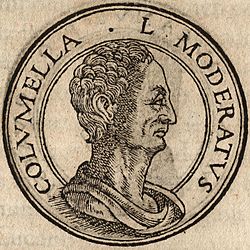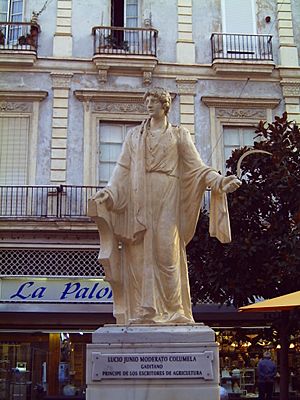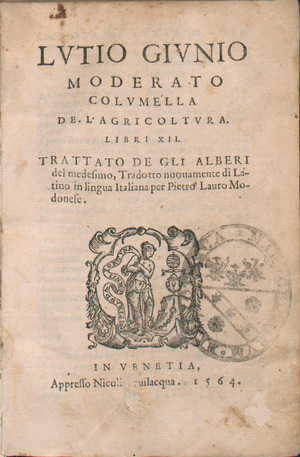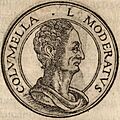Columella facts for kids
Quick facts for kids
Lucius Junius Moderatus Columella
|
|
|---|---|

Portrait of Lucius Junius Moderatus Columella from Jean de Tournes, Insignium aliquot virorum icones, Lyon, 1559
|
|
| Born | 4 AD Gades, Hispania Baetica |
| Died | c. 70 AD |
| Citizenship | Roman |
| Notable works | De re rustica |
Lucius Junius Moderatus Columella (born in 4 AD, died around 70 AD) was a very important writer in the Roman Empire. He wrote mainly about farming.
His most famous work is called De re rustica, which means "On Rural Affairs". This book has twelve parts and is still complete today. It tells us a lot about how Romans farmed. Columella's book is a key source, along with writings from Cato the Elder and Varro. He sometimes even mentions their works.
He also wrote a smaller book about trees, called De arboribus. People usually believe he wrote this one too. Later, in 1794, two Spanish plant experts, Jose Antonio Pavón y Jimenez and Hipólito Ruiz López, named a type of Peruvian plant Columellia after him. This was to honor his work.
Contents
Personal life
We don't know much about Columella's early life. He was likely born in Gades, which is now Cádiz in Spain. His parents might have been Roman.
He served in the army for a while. He was a tribune (a type of officer) in Syria around 35 AD. After his army career, he started farming. He owned farms in places like Ardea, Carseoli, and Alba in Latium, Italy.
De re rustica (On Rural Affairs)
In ancient times, Columella's book was not read very often. Only a few writers like Pliny the Elder mentioned it. It was almost forgotten after another writer, Palladius, made a shorter version.
This book is written as advice to a person named Publius Silvinus. For a long time, only parts of the book were known. But between 1414 and 1418, a scholar named Poggio Bracciolini and his helper found the complete book. They found it in old monastery libraries in Switzerland and France.
What De re rustica is about
The book covers many topics related to farming and managing a farm:
- Soils: How to understand and use different types of soil.
- Viticulture: Growing grapes and making wine.
- Fruits: How to grow various fruit trees.
- Olive trees: All about growing olives.
- Big animals: Taking care of cattle, horses, and mules.
- Small animals: Raising donkeys, sheep, goats, pigs, and dogs.
- Fish and fowl: How to raise chickens, doves, peacocks, geese, ducks, and even manage fish ponds.
- Wild animals: Building enclosures for wild animals and also bee-keeping for honey and wax.
- Gardens: Tips for growing plants in gardens.
- Personnel management: How to manage the people who work on the farm.
- Calendars: Using calendars for farming tasks.
- Household management: Running the farm household.
Book 10 of De re rustica is special. It is written entirely as a poem, like the famous Roman poet Virgil. Some people think this book was meant to be the end of the work. Books 11 and 12 might have been added later.
The first full English translation of the book was published in 1745. Before that, some parts were translated by Richard Bradley.
De arboribus (On Trees)
The shorter book De arboribus means "On Trees." In old copies and early printed versions, it was sometimes seen as the third book of De re rustica. However, it seems to be a separate work, possibly written earlier.
For example, De arboribus does not mention Publius Silvinus, the person De re rustica is written for. A recent study of the Latin text includes De arboribus, but says it's by an unknown author. An ancient writer named Cassiodorus mentioned sixteen books by Columella. This has led some to think De arboribus was part of a different four-volume work.
Images for kids
See also
 In Spanish: Columela para niños
In Spanish: Columela para niños






